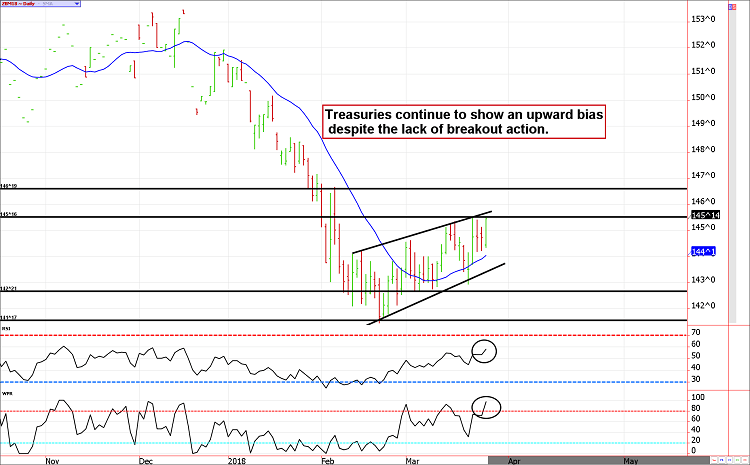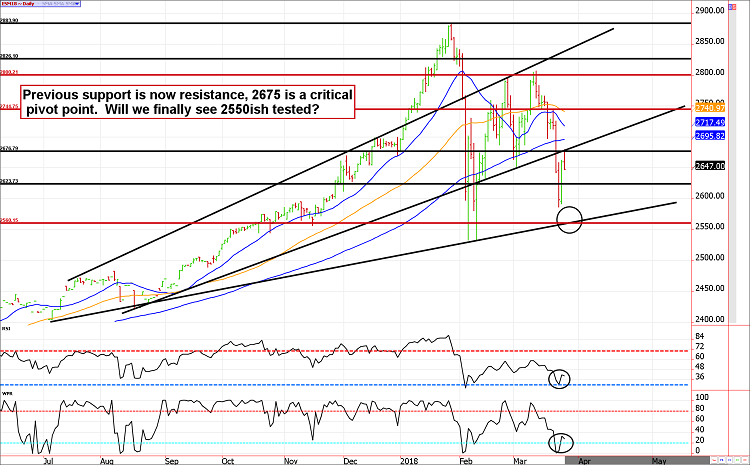Trade tariff talk is just that, we've yet to get anything concrete. Yet, the market is emotional.
This is nothing new, if there is anything we've learned from the first year (+) of the Trump presidency it is the conversation always starts with drama, but then settles down to something more reasonable. Unfortunately, the markets haven't quite figured that out yet. Those that believe markets are efficient, will have a hard time explaining what we've seen in the previous three or four trading sessions.
Tariff discussions, without any concrete decisions, can't explain such big swings in asset prices. The only rational explanation for this type of volatility is (ironically) irrationality. Markets are emotional, and we are being reminded of that. The low volatility slumber of 2016 and 2017 were anomalies and are probably behind us.
The "buy and holders" might not be happy with the market environment before us, but the reality is the expanded volatility will eventually provide opportunities for traders (particularly option sellers). Further, it might not feel like it but this is a healthier market than what we saw in late 2017 and January 2018.
Treasury Futures Markets

The 30-year will need to poke over 146 to confirm a trend change.
Anybody who has been following this newsletter knows we have been perpetually bullish Treasuries since early February. It has been a long and boring ride, but the bond market is finally starting to react to its surroundings. Although stock market volatility has ticked up in recent months, Treasury (and even currency) volatility is still extremely low relative to historic norms. As complacent stock index traders learned in January, low volatility can last for extended periods of time but it never lasts forever.
Given the mass number of short market participants in the 10-year note futures contract, there could be a surprisingly sharp short squeeze on the horizon.
Treasury futures market consensus:
The ZB needs to print above 146'0 to confirm a trend change.
**Technical Support:** ZB : 143'23, 142'21, 141'17 and 140'19 ZN: 120'04, 119'26, 119'16 and 119'08
**Technical Resistance:** ZB: 146'03, and 146'24 ZN: 121'01, 121'15, and 122'01
Stock Index Futures

We can't rule out a quick test of 2550, but most of the selling has likely already been seen
Seasonal tendencies are leaning higher in the coming weeks and support should be seen near 2550ish. Things are going to be messy in the short-run, but trendline support "should" continue to hold for now. If you are a bull, well-hedged positions (or even limited-risk long call options) are probably worth a shot somewhere between 2560 and 2550 but traders will need to be quick-triggered; those prices might not last long.
That said, it is time to consider the possibility that the bull market we've all grown to love over the last 9 years could be slowly dying.
Stock Index Futures Market Ideas
**E-mini S&P Futures Market Consensus:**
2675 resistance held and the market quickly fell apart. We will likely see a full test of the trendline near 2550/2560.
**Technical Support:** 2560 and 2530
**Technical Resistance:** 2675, 2744, 2799, 2830, and 2882
E-mini S&P Futures Day Trading Ideas
**These are counter-trend entry ideas, the more distant the level the more reliable but the less likely to get filled**
ES Day Trade Sell Levels: 2664, 2697, and 2744
ES Day Trade Buy Levels: 2580, 2560, and 2544
In other commodity futures and options markets....
January 30 - Buy June ZN near 121'09, sell an April 121 call and buy a March 120 put as catastrophic insurance.
February 15 - Sell May ZN 121 call to refresh bullish ZN position hedge.
February 20 - Buy back April 121 ZN call to lock in gain, sell March ZN put near breakeven.
February 21 - Sell long June ED 98 put to lock in a profit of anywhere from $550 to $600. This leaves our long futures contract underwater and "naked".
March 2 - Sell May soybean meal future near 3.95, sell a May 3.95 put then buy an April 4.30 call for insurance.
March 8 - Sell a June 121 10-year note call against the long futures position (hold short May 121 call).
March 15 - Exit covered put in May soybean meal to lock in a gain of about $850 prior to transaction costs.
March 20 - Go long June soybean meal futures near 363 and sell a June 360 call against it. Purchase a May 340 put for catastrophic insurance.
March 20 - Buy back May ZN 121 call to lock in the profit (roughly $250 per lot before transaction costs) and sell the June 121 call for about 30 ticks to freshen up the hedge going into the Fed meeting (this leaves the position with a long June 10-year note futures contract and 2 short 121 calls).
March 21 - Sell the June live cattle 102 put and purchase the April cattle 113 put for insurance (the April cattle is trading much higher than June).
March 23 - Go long July corn future, buy a July 3.80 put and sell a July 4.10 call. The net out of pocket expense and risk is roughly 7.5 cents or $375, max profit potential is about $1,050 before commissions and fees.
March 27 - Go long July sugar 13.50 calls near 27 ticks or roughly $300.
**There is substantial risk of loss in trading futures and options.** These recommendations are a solicitation for entering into derivatives transactions. All known news and events have already been factored into the price of the underlying derivatives discussed. From time to time persons affiliated with Zaner, or its associated companies, may have positions in recommended and other derivatives. Past performance is not indicative of future results. The information and data in this report were obtained from sources considered reliable. Their accuracy or completeness is not guaranteed. Any decision to purchase or sell as a result of the opinions expressed in this report will be the full responsibility of the person authorizing such transaction. Seasonal tendencies are a composite of some of the more consistent commodity futures seasonals that have occurred over the past 15 or more years. There are usually underlying, fundamental circumstances that occur annually that tend to cause the futures markets to react in a similar directional manner during a certain calendar year. While seasonal trends may potentially impact supply and demand in certain commodities, seasonal aspects of supply and demand have been factored into futures & options market pricing. Even if a seasonal tendency occurs in the future, it may not result in a profitable transaction as fees and the timing of the entry and liquidation may impact on the results. No representation is being made that any account has in the past, or will in the future, achieve profits using these recommendations. No representation is being made that price patterns will recur in the future.
Due to the volatile nature of the futures markets some information and charts in this report may not be timely. There is substantial risk of loss in trading futures and options. Past performance is not indicative of future results. The information and data in this report were obtained from sources considered reliable. Their accuracy or completeness is not guaranteed and the giving of the same is not to be deemed as an offer or solicitation on our part with respect to the sale or purchase of any securities or commodities. Any decision to purchase or sell as a result of the opinions expressed in this report will be the full responsibility of the person authorizing such transaction.
Recommended Content
Editors’ Picks
EUR/USD clings to daily gains above 1.0650

EUR/USD gained traction and turned positive on the day above 1.0650. The improvement seen in risk mood following the earlier flight to safety weighs on the US Dollar ahead of the weekend and helps the pair push higher.
GBP/USD recovers toward 1.2450 after UK Retail Sales data

GBP/USD reversed its direction and advanced to the 1.2450 area after touching a fresh multi-month low below 1.2400 in the Asian session. The positive shift seen in risk mood on easing fears over a deepening Iran-Israel conflict supports the pair.
Gold holds steady at around $2,380 following earlier spike

Gold stabilized near $2,380 after spiking above $2,400 with the immediate reaction to reports of Israel striking Iran. Meanwhile, the pullback seen in the US Treasury bond yields helps XAU/USD hold its ground.
Bitcoin Weekly Forecast: BTC post-halving rally could be partially priced in Premium

Bitcoin price shows no signs of directional bias while it holds above $60,000. The fourth BTC halving is partially priced in, according to Deutsche Bank’s research.
Week ahead – US GDP and BoJ decision on top of next week’s agenda

US GDP, core PCE and PMIs the next tests for the Dollar. Investors await BoJ for guidance about next rate hike. EU and UK PMIs, as well as Australian CPIs also on tap.